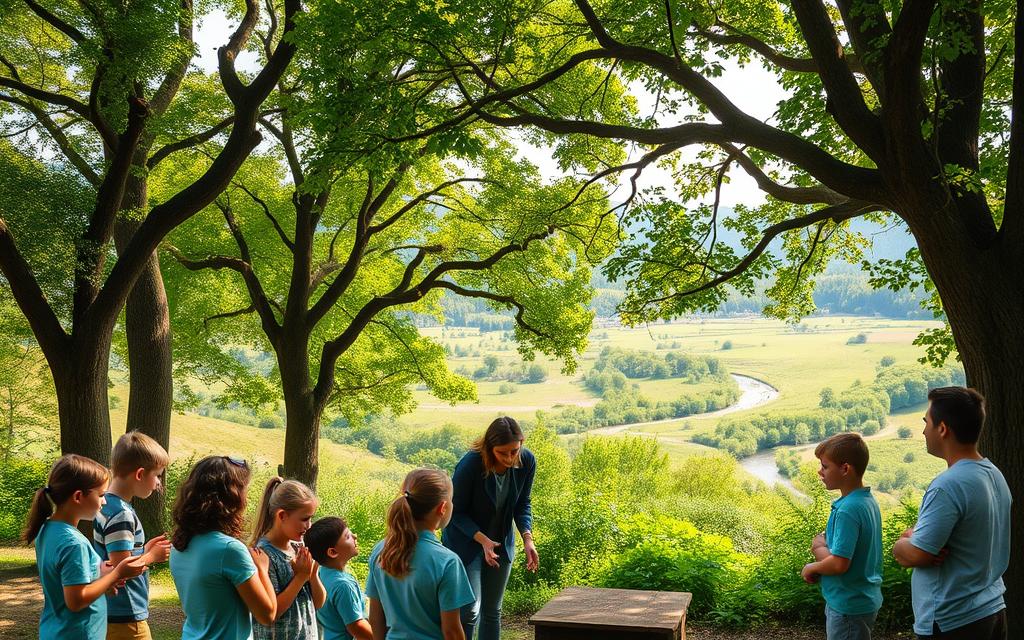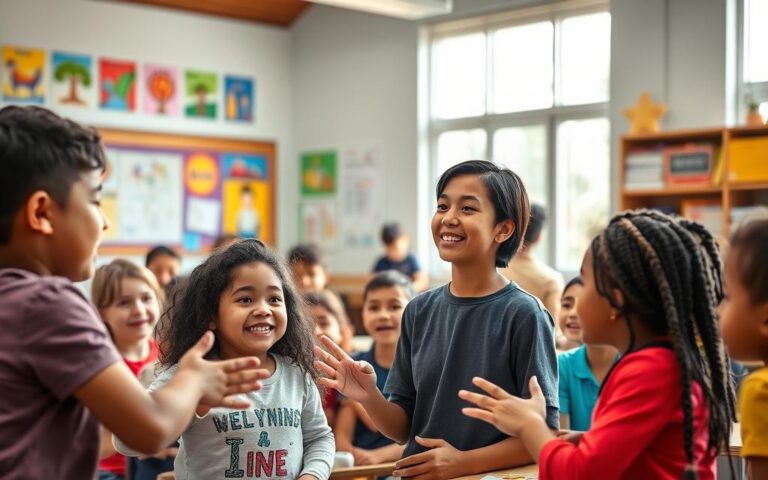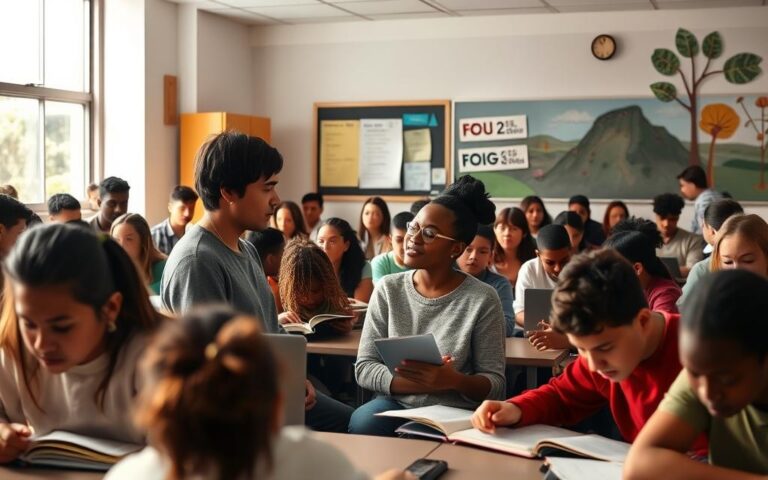adversiment
Outdoor education helps students grow stronger in many areas. They learn better critical thinking, teamwork, and how to handle challenges. They also become more caring about the environment. This is true for students in K–12 and secondary schools in the United States.
Studies from groups like the National Outdoor Leadership School (NOLS) and Outward Bound show great results. Students who learn outside do better in school and feel better about themselves. These findings help schools bring outdoor learning to more students.
This article will explain what outdoor education is and its benefits. It will look at how it helps in STEM and teaching about the environment. You’ll also see examples of outdoor education programs and how to make them more accessible. It’s packed with useful tips and ideas for educators, administrators, parents, and policymakers.
What is Outdoor Education?
Outdoor learning mixes classroom goals with time in nature. It uses hands-on activities, field studies, and reflection to meet standards. Programs range from short lessons to multi-day stays in parks.
This learning is different from outdoor recreation. It focuses on learning outcomes linked to the curriculum. It also connects with place-based education and forest school models, but keeps academic goals in mind.
Definition and Overview
Outdoor education is learning that happens outside. Students work directly with nature while teachers guide them. It includes safety, experiments, and connections to the classroom.
Schools and nature centers offer outdoor programs. These programs mix environmental education with other subjects. They use tools like field journals and maps for learning.
Lessons end with reflection, linking what was learned to standards and goals.
Historical Context
Outdoor learning’s roots go back to progressive education in the 19th and early 20th centuries. John Dewey believed in learning by doing. Kurt Hahn started Outward Bound in 1941 to build resilience through outdoor challenges.
After World War II, conservation education grew in U.S. schools. Outdoor programs became more popular from the 1970s to the 1990s. Today, there’s a renewed focus on environmental education and outdoor programs.
The Benefits of Outdoor Education
Learning outside boosts students’ physical, mental, and social skills. Schools that use nature-based learning see more activity, better moods, and stronger teamwork. Here are the main areas where outdoor education shines.
Physical Health Advantages
Outdoor lessons make students more active than indoor classes. Activities like trail hikes, outdoor play, and wildlife surveys improve heart health and motor skills.
Adding outdoor education to school schedules lowers obesity risk. Even simple changes, like a nature walk instead of a classroom lesson, boost heart health and stamina.
Mental Health Benefits
Being in nature reduces stress and boosts focus and mood. Studies show that nature lowers anxiety and depression.
Nature-based learning makes students more engaged and focused. Outdoor lessons and sensory activities improve learning retention. Mindfulness walks and guided observations help with emotional control and focus.
Social Skills Development
Outdoor activities promote teamwork, communication, and problem-solving. Students learn to work together on tasks like building shelters and conducting field studies.
Outdoor education also boosts social skills. Through peer teaching, leadership, and team challenges, students develop empathy and teamwork skills. These skills help them work well together in school and life.
Enhancing Critical Thinking Through Nature
Outdoor experiences sharpen judgment and spark curiosity in ways classroom work alone cannot. When students step into forests, wetlands, or schoolyards, they meet real problems. These problems require observation, testing, and clear reasoning.
Fieldwork turns abstract steps of the scientific method into practical moves. Learners form hypotheses, gather data, and revise plans after direct feedback from the environment. Teachers and youth programs use outdoor education resources to set challenges that teach careful measurement and actual evidence-based conclusions.
Practical problem-solving appears in many simple activities. A navigation task asks groups to choose routes that balance time, safety, and learning aims. A shelter-building exercise forces teams to use limited materials and test structural ideas.
These moments teach decision-making under uncertainty and promote iterative thinking.
Hands-on projects in nature encourage experimentation and systematic record keeping. Students carrying out stream sampling, soil testing, or species counts learn to analyze patterns and draw defensible conclusions. These skills translate to lab work, science fairs, and community projects tied to experiential learning.
Open, unstructured settings invite creative thinking. Nature journaling, ecosystem art, and design challenges push learners to imagine multiple solutions for the same problem. Creativity here means generating options, testing prototypes, and adapting ideas to real constraints.
Programs that use outdoor education resources often pair creative tasks with reflective prompts. This mix helps students practice lateral thinking and build resilience when initial ideas fail. The result is a stronger capacity to innovate in STEM, the arts, and civic work.
Below is a compact comparison of common outdoor activities, the thinking skills they build, and the typical resources needed. Use this as a quick guide when planning lessons that emphasize experiential learning.
| Activity | Core Thinking Skills | Typical Outdoor Education Resources |
|---|---|---|
| Stream sampling and analysis | Observation, hypothesis testing, data interpretation | Sampling nets, pH strips, field notebooks, identification guides |
| Navigation and route planning | Problem solving, risk assessment, decision-making | Maps, compasses, GPS units, time-management worksheets |
| Shelter or bridge build | Engineering thinking, prototype testing, teamwork | Ropes, tarps, tapes, simple tools, safety gear |
| Ecosystem art and design challenges | Divergent thinking, resourcefulness, aesthetic reasoning | Natural materials, sketch pads, basic craft supplies, cameras |
| Long-term monitoring projects | Pattern recognition, statistical thinking, sustained inquiry | Data sheets, cloud storage or spreadsheets, identification keys |
Building Teamwork and Leadership Skills
Outdoor lessons help students work together on real tasks. They learn to assign roles, plan, and share duties. This way, they improve communication and accountability.
Tasks like ecological studies and community garden projects show the importance of teamwork. Roles change so everyone gets to lead and follow. Reflections turn these experiences into learning, improving teamwork and classroom atmosphere.
Collaborative Learning Environments
Outdoor school programs focus on hands-on projects that need teamwork. For example, in a transect study, one student records species while another maps locations. This builds problem-solving and task allocation skills.
Activities like garden projects offer chances for peer feedback. Teachers lead short debriefs to enhance accountability. Students feel more trust in their classmates and show better verbal teamwork skills.
Leadership Opportunities in Outdoor Settings
Outdoor settings provide chances for leadership, like being a navigator or safety officer. These roles help students practice decision-making and risk assessment in a safe environment.
Programs like Outward Bound and school leadership curricula focus on experiential learning. Students set goals, lead teams, and mentor peers. They see long-term benefits in self-confidence, initiative, and leadership skills, useful in school projects and clubs.
The Role of Outdoor Education in STEM Learning
Outdoor settings make STEM ideas real for students. Field work sparks curiosity and improves lab skills. Teachers use outdoor education to make STEM part of everyday lessons.

Hands-On Science Activities
Experiments like water quality testing and soil analysis happen outside. Students collect data, practice measuring, and sharpen their observation skills. Tools like portable lab kits and iNaturalist help with these activities.
These field experiments align with Next Generation Science Standards. Students learn to plan and analyze their work. Teachers guide them through the research process in short cycles.
Nature as a Laboratory
Nature offers systems and processes that classrooms can’t replicate. Ecosystems and weather patterns are perfect for learning. Students apply math and engineering in these settings.
Projects that span subjects help students understand concepts better. Nature-based learning makes learning fun by solving real-world problems. It also teaches scientific thinking and habits.
Practical ideas for teachers
- Run a schoolyard biodiversity survey and analyze species counts with basic statistics.
- Use soil probes to compare pH and texture at different sites, then graph results.
- Partner with local conservation groups to join citizen science efforts and access data tools.
Environmental Awareness and Responsibility
Hands-on experiences help students connect classroom concepts to real places. Lessons outside make it easier to see how plants, insects, soils, and water link together. This practical approach supports environmental education and builds lasting habits.
Understanding Ecosystems
Field investigations let learners map food webs and note seasonal changes. Teachers and park educators lead activities in schoolyards, nature centers, and local parks. These outings include species ID, habitat assessments, and short pre- and post-assessments to track learning.
Partnerships with park districts and conservation groups deepen ecological literacy. Students practice measuring soil, surveying plants, and observing succession. These tasks make abstract ideas concrete.
Promoting Sustainability
Service-learning projects link lessons to community action. Activities such as native plantings, stream cleanups, and waste reduction campaigns give students roles in stewardship. These experiences are common in outdoor classrooms and make sustainable habits visible.
A well-designed outdoor education curriculum includes citizen-science monitoring and water-conservation exercises. Repeated practice in these areas raises pro-environmental attitudes. Long-term reinforcement increases the chance students keep these behaviors into adulthood.
Developing Resilience and Grit
Outdoor programs offer a chance for students to face challenges. In nature, they learn to navigate, adapt to weather, and overcome obstacles. These experiences help them develop skills that benefit them in school and at home.
Overcoming Challenges Outdoors
Outdoor education activities often have clear, solvable problems. For example, an expedition hike requires teamwork and planning. Challenge courses break down big goals into smaller, doable steps.
Students set goals, practice, and reflect on their progress. Instructors from places like Outward Bound and the National Outdoor Leadership School track their growth. They find that students stay committed longer and feel more confident in class and personal projects.
Learning from Failure
Safe risk-taking turns failure into a learning opportunity. When a shelter collapses, groups try new ideas. Navigation mistakes teach valuable lessons about planning and backup strategies.
Debriefs led by instructors help turn setbacks into lessons. Tools like journals and peer feedback solidify these lessons. Outdoor learning helps young people see failure as a chance to grow, fostering resilience and a growth mindset.
Outdoor Education Curriculum Examples
Hands-on lessons make learning stick. Below are models that blend subjects and bring classrooms into the field. These examples show how an outdoor education curriculum can meet standards while using local places as learning labs.
Integrative Learning Experiences
A watershed unit ties science, language arts, social studies, and math to one place-based theme. Students test water quality, write persuasive pieces on conservation policy, map drainage patterns, and research local history. Lessons align with NGSS performance expectations and state standards through clear learning targets and rubrics.
Assessment uses competency checklists and portfolios. Teachers adapt tasks by grade level so middle schoolers run hydrology experiments while high schoolers design policy briefs. Ready lesson plans speed planning and let educators focus on facilitation.
Field-Based Learning Activities
Concrete activities engage observation, data skills, and civic science. Examples include quadrat sampling for biodiversity, plant identification hikes, outdoor math trails, and weather-data collection with simple instruments. Students can submit sightings to iNaturalist or contribute bird counts via eBird.
Logistics notes help with classroom management. Typical lesson length ranges from 45 minutes to a full day. Optimal group size is 6–12 students for hands-on tasks. Materials lists, safety plans, and accessibility adjustments ensure inclusive participation.
Assessment methods vary by project. Portfolios, lab reports, and presentations capture skills and content knowledge. Teachers use rubrics that map to standards and to outdoor education activities so progress stays measurable.
| Unit | Sample Activities | Standards & Assessment | Resources |
|---|---|---|---|
| Local Waterways |
|
|
|
| Biodiversity Monitoring |
|
|
|
| Outdoor Math Trail |
|
|
|
Many publishers and organizations offer ready-made outdoor education resources that ease planning. Project Learning Tree and the National Environmental Education Foundation provide vetted lesson plans for diverse settings. State education departments often publish alignment guides and safety checklists.
Using these examples helps teachers build a practical, standards-driven outdoor education curriculum that centers student inquiry. Small adaptations keep activities accessible, safe, and aligned to measurable learning goals.
Inclusive Practices in Outdoor Education
Outdoor learning spaces welcome all students. Schools and parks can make these spaces accessible with simple design changes and clear plans. This approach boosts participation, safety, and joy for everyone.
Adapting Activities for All Students
Start with universal design for learning to offer different ways to learn. Use tactile guides, raised-bed gardens, and large-print signs for those with visual needs.
Make sure trails and seating areas are wheelchair-accessible. Offer flexible pacing and breaks for students with physical or energy limitations. This way, everyone can participate fully.
Provide many ways for students to express their learning. They can do oral reports, create visual maps, or build hands-on models. Train staff on disability inclusion and have individual health plans ready.
Benefits for Diverse Learning Needs
Outdoor settings can reduce sensory overload for many students. The natural sounds and open space can help those with ADHD or autism spectrum disorder focus better.
Multi-sensory activities help learners who process information differently. Using plants, textures, and movement supports kinesthetic and tactile learners.
Culturally responsive practices make lessons more relevant. Invite local community knowledge and use outdoor education resources that reflect students’ backgrounds and traditions.
Schools that invest in inclusive outdoor education see better engagement and behavior. Thoughtful planning turns outdoor classrooms into places where everyone can explore and grow.
The Future of Outdoor Education
The way we learn outside the classroom is evolving quickly. Schools, parks, and nonprofits are exploring new ways to bring nature into learning. This change is shaping the future of outdoor education and guiding teachers in using outdoor resources.
Trends and Innovations
Now, schools mix classroom lessons with short outdoor sessions. Teachers use tools like remote sensors and GIS to teach science in real-world settings. Virtual reality gives students a preview of what they’ll learn outside.
Partnerships with citizen-science projects help schools collect important data. Districts are creating green schoolyards and hiring outdoor education coordinators. Microgrants and partnerships fund new projects and grow successful ones.
Researchers are studying the long-term effects and finding common ways to measure success. Cost-benefit analyses help decide which programs to expand. This makes it easier to compare different approaches.
Expanding Access to Outdoor Learning
But, there are challenges like transportation, funding, and safety issues. It’s important to make outdoor learning accessible to all, so every child can have hands-on experiences.
Grants from the federal and state governments, along with nonprofits like the National Park Service, support mobile units and greening schoolyards. Cities are turning empty lots into learning gardens, helping neighborhoods with few parks.
Policies can help keep progress going. States that include outdoor learning in standards show districts that it’s worth investing in. Incentives for professional development help teachers learn new methods and use outdoor resources better.
Steps taken by districts, community partners, and funders will shape how widely students experience nature-based learning. This could lead to more resilient and inclusive programs that reach diverse learners across the United States.
Conclusion: The Lasting Impact of Outdoor Education
Outdoor education does more than create memories; it builds skills for life. It enhances critical thinking, teamwork, leadership, and resilience. It also boosts scientific knowledge and a love for nature.
These skills help students succeed in school and prepare them for STEM and conservation careers. They also encourage students to get involved in their communities.
Studies show that outdoor learning leads to lasting environmental attitudes and actions. Schools that focus on outdoor education see students who care more about the environment. They are more likely to choose science-based careers.
Hands-on outdoor learning makes learning stick and inspires students to solve real-world problems. It’s a powerful way to teach environmental education.
Educators, school leaders, parents, and policymakers can make outdoor education more accessible. They can support outdoor school programs and integrate outdoor classrooms into learning plans. They can also help teachers learn how to teach outdoors.
Resources like Project Learning Tree and the Children & Nature Network offer tools to help. They provide materials and support for outdoor education.
By focusing on outdoor education, American students can tackle big social and environmental challenges. Schools can help raise a generation that cares about nature and is ready to lead.



